Socrates Pattersonof Vathy, Turkey and New London, Connecticut |
|||||||
 |
|||||||
|
J ohn Socrates Papanagnosti emigrated to the United States in 1893. Ship manifests and his passport applications document him leaving Constantinople on 20 October 1893 [1], then departing Liverpool, England around 29 October 1893 aboard the Lucania, and arriving at New York Harbor on 3 November 1893 [2] [3]. He lists his birthdate as 28 September 1872 [4] [5] [6], so he had just turned 21 years of age when he left Constantinople. He lists his place of birth varyingly as Vathe, Turkey [7] [8] and Vathi, Greece[9], his legal name as J. Socrates Papanagnoste [10], John Socrates Papanagnoste [11], or Socrates Patterson [12], and his father as Nicholas Papanagnoste [13], although records for his siblings give their parents' names as Notas and Helen [14] [15] [16]. It's possible that the spoken name "Notas" was mistranscribed as "Nicholas" on Socrates' passport application.
|
|||||||
|
|
|||||||
|
The Location of Vathe/ Vathé /Vathy/Bathey and
Origins of the Surname Papanagnosti/Papanagnoste |
|||||||
| In a letter from Rex (Xenophon) Patterson (second-born son of John Socrates and Helen Papanagnosti) to his younger half-sister, Mary Kelles Stone [17], Rex informed Mary that his father’s name was “Socrates Papagnosti”, that Socrates’ father “was a High Priest who had a big estate with a castle on it and lots of land & was very wealthy. When the Turks plundered Greece, they took away everything from him. He also was born in a little island off Greece, called Vathé, Turkey.” T
|
|||||||
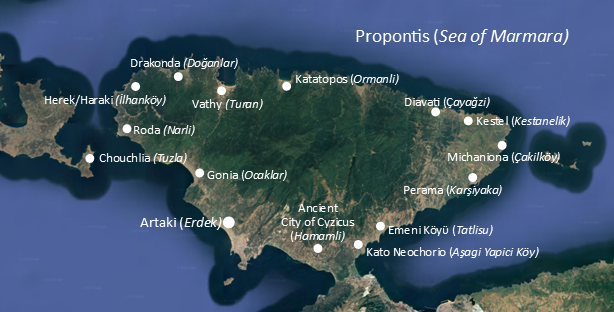 Map of Kapıdağ Peninsula with location of Vathy, now called Turan. Map names: The Encyclopaedia of the Hellenic World |
|||||||
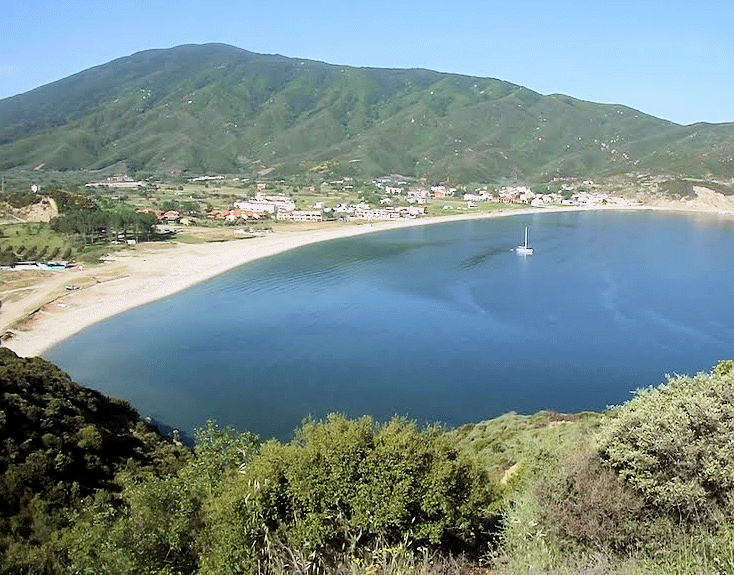 Once a Greek Orthodox fishing village, Vathy is now a Turkish resort town known as Turan or Turan Köy |
|||||||
|
Rex Patterson’s account that Socrates’ father was “a High Priest” was probably based on fact. According to Greek etymology, surnames beginning with “Papa” indicate descent from a Greek Orthodox priest; papa from the Greek word from παπάς or “priest”. The second half of the surname, anagnoste or anagnosti, comes from the Greek word, αναγνώστης, Anagnostis or Anagnostes, which means “one who reads”. It can also refer to the clerical order of “reader” in the Greek Orthodox Church. The 1841 Ottoman Census identifies a Greek Orthodox priest living in Vathy Kyzikus named Papa Dimitri with two sons, Yanakis, age 26, and Anagnostis, age 15. It is believed that Anagnostis, like his father, became a Greek Orthodox priest, thereby giving his descendants the patronymic surname Papanagnosti. He was very likely John Socrates Papanagnosti's grandfather. Rex also reported that Socrates’ father “had a big estate with a castle”. This too may have some basis in fact, as the Panagia Theotokos Faneromeni," or “Kirazli Monastery (Monastery of Cherries)” as it is known in Turkish, is located on the peninsula. The monastery was one of the most significant Greek Orthodox monasteries in Anatolia, containing more than 90 rooms and a notable church. The monastery was abandoned in 1922, possibly coincident with the Greek-Turkish population exchange. |
|||||||
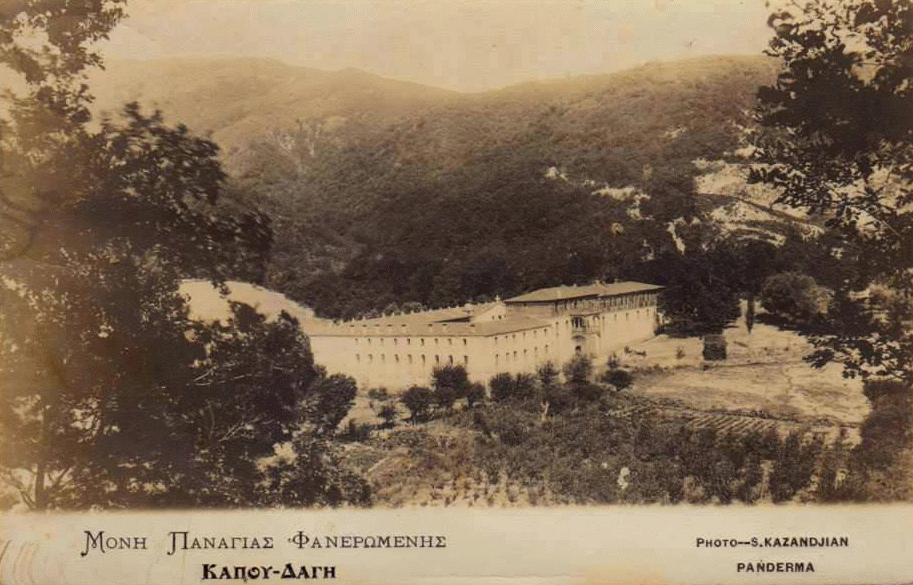 Panagia Theotokos Faneromeni when it was a functioning Greek Orthodox monastery. |
|||||||
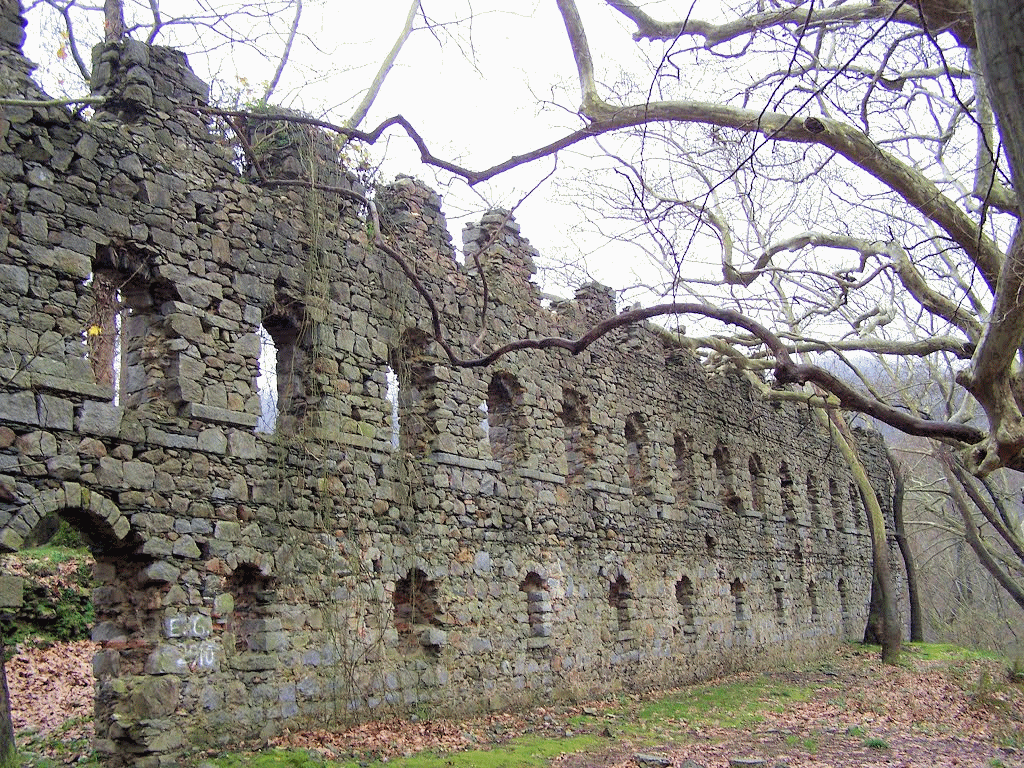 The ruins of Panagia Theotokos Faneromeni today. |
|||||||
 |
|||||||
|
A Brief Summary of Socrates’ Life from 1893 to 1920 |
|||||||
|
Following Socrates’
arrival in the U.S. in 1893, he resided in New York and New London,
Connecticut.
In 1902 and 1905 passport applications, he gave New York City
addresses and contacts (John P. Diamantopolis at 3 Cedar Street, and
D. Barrow at 55 Dey Street), indicating that he still spent some of
his time in New York City
[21][22]
|
|||||||
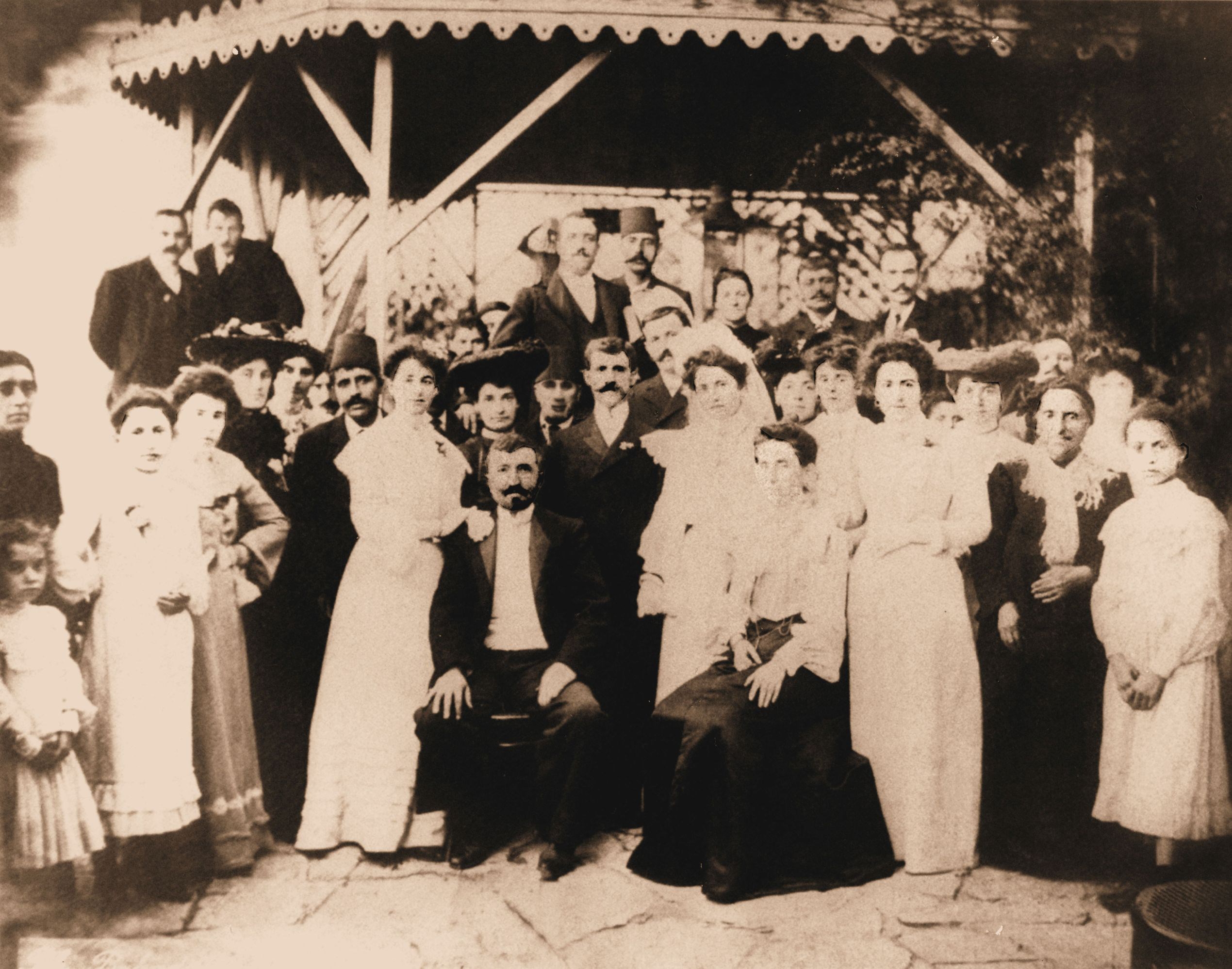 The Wedding of Socrates Papanagnosti and Helen Kelessidis, 1903 Socrates and Helen are standing in the center. Helen's father George Kelessidis is seated to the left of Socrates and her mother, Caroline Kelessidis is seated to the right of Helen. Helen's sister Hariklia is standing to the right of her mother, Caroline Kelessidis. It's not clear who the young woman is standing to the left of George Kelessidis. |
|||||||
 Socrates and Helen Patterson shortly after their wedding |
|||||||
 |
|||||||
|
A 17 July 1903 article in The Day reported that Socrates' store at 82 State Street had been broken into and money ($5) had been taken from the cash register. The article noted that Socrates was away in Greece and the store was under the charge of Vasil Vardopolis, who had closed the store at around 11 p.m., leaving about $5 cash in the register. The next morning, Socrates' nephew, Stavros Peterson, opened the store and found no cash in the register. Stavros notified Vardopolis who discovered that a window had been broken into at the back of the store and notified police.[37] Socrates returned to the United States with his bride in late summer or early fall 1903. There is a ship's passenger record for an S. Patterson and Mrs. Patterson, naturalized citizens, arriving in New York on 17 October 1903.[38] S. Patterson was age 30, so born about 1872-3, which is the right age for Socrates, however the age of Mrs. Patterson was given as 25, much older than Helene's actual age of 17. It's possible they felt the need to hide her true age. Socrates' passport gave his name as J. Socrates Papanagnoste, but he was using his anglicized name for business, however it's not known how closely ships records followed the names on passports. No information was given on this couple's place of birth or final destination, so there's no way to be certain if this was Socrates' and Helene's record. No other ship record has been found for them in 1903. Shortly thereafter, Socrates moved his confectionary business to 86 State Street, which he named the Crystal Candy Kitchen. On 11 July 11 1904, Socrates and Helene's first child, Dionysius, was born [39]. An article in The Day [40] announced the christening of Dionysius according to Greek Orthodox rite on 20 July 20 1904. The ceremony was performed by the Reverend Zissimos G. Typaldos, rector of the Greek Orthodox Church in New York who travelled to New London to perform the christening. The godfather was Denis C. Bossos of New York, manufacturer of Prince George of Greece cigarettes, who christened Dionysius "Denis". Helene's parents, George and Caroline Kelessidis, travelled from Constantinople to be there for Denis' birth and christening. He and Helene were living in an apartment at 23 Howard Street [41] [42]
Socrates, Helene and their family members
traveled fairly often during their marriage:
|
|||||||
|
|
15 September 1905: Socrates applied for another passport, probably because Helene had modified his existing passport for herself. Socrates noted he intended to return to the U.S. “within one year” [2].
13 May 1906: Socrates and Helene were listed on the
manifest of the S.S. St. Paul along with their
two young children, Denis, one year, 8 months old, and Xenophon, 9
months old, and Soteria Patterson (Socrates’ younger sister), sailing from
Cherbourg, France on May 5, 1905 and arriving at New York Harbor on May 13, 1906.[27] This was likely Sotera's
first trip to the U.S. Soteria married George Cozakos on 23
February 1910 in New London
[28],
and they shortly thereafter moved to Salt Lake City, Utah, where he worked as a confectioner.[29]
The Cozakos family came from Vathy and its neighboring village
27 July 27 1911: Helene applied for a passport
for herself, 4-year-old Constantine and 3-year-old George to travel
abroad, probably back to Constantinople to see her parents.[32]
29 July 1912: Helene's mother, Callirhoi (Caroline) Kelessidis and 2-year-old Ponteles "Ponte" Patterson arrived in New York, embarking on the SS Athinai at Calamata, Greece. Caroline listed their last permanent address as Piraeus, Greece, and she listed George Kelessidis' cousin, Michael Kelessidis as her contact in Piraeus. It's not clear if Caroline had permanently left Constantinople or if she was just visiting Michael Kelessidis. George Kelessidis was living in Constantinople at least until 1920. Apparently Ponte was visiting with his grandmother on his own [34]. 29 July 1912: On the same ship as Helen's mother Callirhoi (Caroline) and son Ponte, but embarking at Athens, Helene's cousin Constantine Kelessidis (Gus Kelles), age 23, arrived in New York. He was the son of George Kelessidis' cousin Michael Kelessidis. [35]
30 September 1913: Helene’s father George Kelessidis, age
57, travelled aboard the S.S. Athinai, from
Piraeus, Greece to New York to visit the family in New London.
He listed Socrates as his "brother-in-law" on the manifest.
|
||||||
|
Assisting Family and Friends with Immigration to the U.S. In addition to travel within the immediate family, Socrates, and later Helene, were instrumental in helping many Greek friends and family members immigrate to the U.S., primarily from Turkey. Between 1906 and 1923, at least 26 individuals listed either Socrates or Helene as their point of contact in the U.S on ship's manifests. Half of these individuals identified Socrates and Helene as family members. Some of the names are familiar - Balassi, Tsakmakidis, Kelesside, but many are not. During this time period, Greeks in Turkey were increasingly persecuted and mistreated. This culminated in the Turkish-Greek Population Exchange of 1923. Many historians consider the population exchange a "legalized form of ethnic cleansing" (Pinxten & Dikomitis, 2009; Shields, 2013). Millennia of Greek habitation and history was erased in a few short years in order to rid the region of the indigenous Orthodox Christian peoples of Turkey. Socrates and Bright's Disease According to the family, some of the trips Socrates made to Europe and Asia Minor included stopovers in Paris, where Socrates sought treatment for a hereditary condition, Bright's Disease, a catch-all term for what is known today as chronic or acute nephritis. A diagnosis of Bright's Disease in the early 20th century was grim; the condition was considered fatal. In 1912, it was the fourth-leading cause of death in the United States.[39] The disease was first described by Richard Bright in the 1827. In the early 20th century, Thomas Addis was at the forefront of research and treatment for the disease. Acute Bright's Disease was treated with local depletion (bleeding or blood-letting to reduce blood pressure), warm baths, diuretics, laxatives, and dietary modifications.[40] Unfortunately, effective treatment for the disease was not successful until the 1950s. At some point in later 1905 or early 1905, Socrates travelled to Europe or Asia Minor, because he is listed on the manifest of the S.S. St. Louis on April 16, 1905, New York from Cherbourg, France[25]. Perhaps this was when his treatments for Bright's Disease began. One month
later, on May 13, 1905, Helene applied for a passport for herself and
her minor child, Dionysius
[26].
She listed her place of birth as Büyükdere, Turkey and her date of
birth as "on or about the .....day of July 1884",
claiming she was 21 years old, although her actual birthdate was 10
February 1886 and she was 19 years old. She was nearing the end
of her pregnancy with her second
child, because on June 19, 1905, Helene gave birth to Xenophon in
Cairo where she had been visiting with her parents. It seems
that Socrates was not with her, because on 15 September 1905, he
applied for another passport to travel abroad, this time intending to
return to the U.S. “within one year”[2].
He no doubt was travelling to bring his young family home. |
|||||||
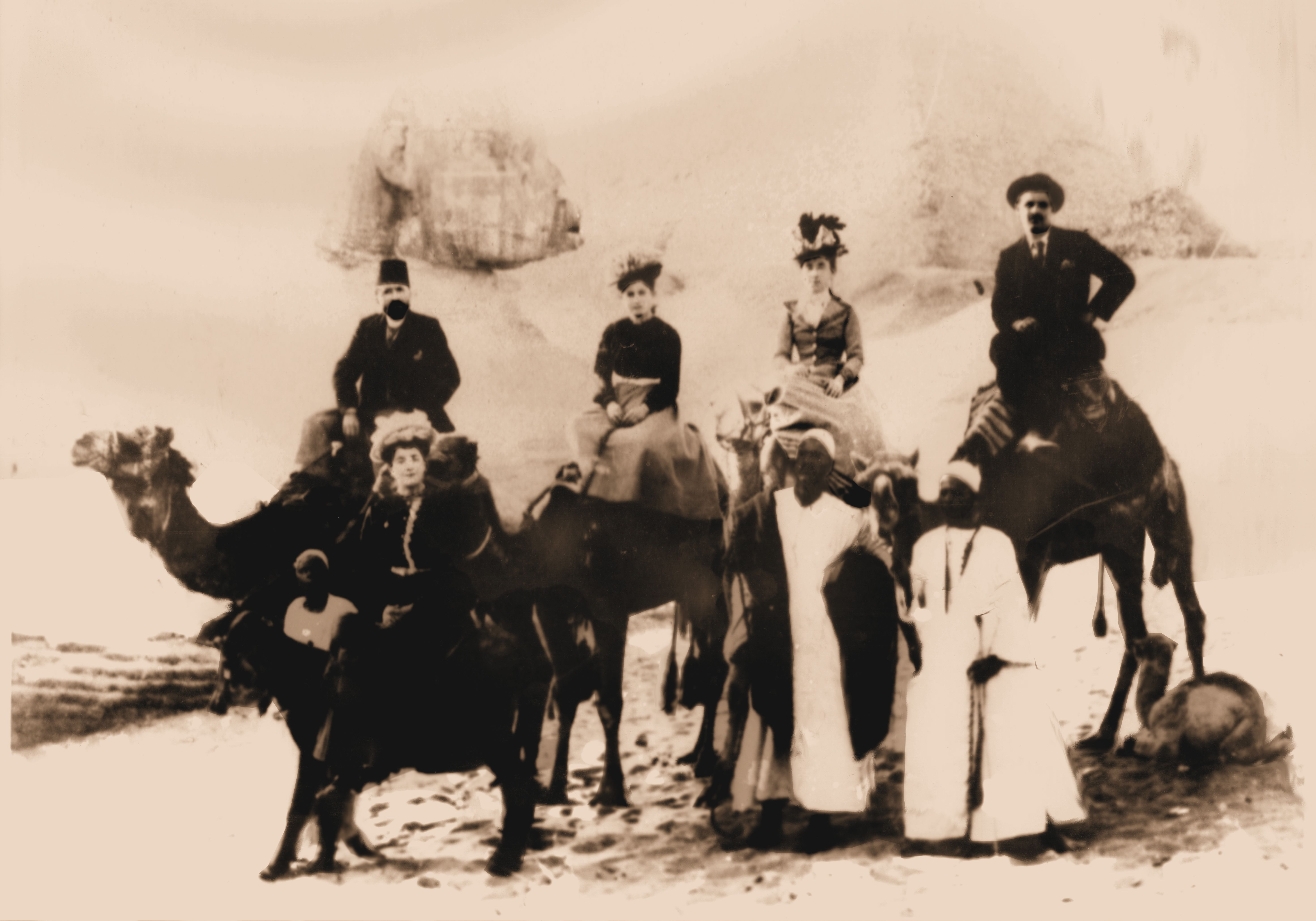 The Kelessidis family in Egypt From back left: George Kelessidis (Helene's father), Helene Kelessidis Patterson, Caroline Kelessidis (Helene's mother), Unknown man From front left: Unknown man, Helene's sister, Hariklia, Unknown Man, Unknown Man |
|||||||
|
The family must have remained abroad through 1906. On 5 May 5 1906, Socrates, Helene, Denis - one year, 8 months old, and Xenophon - 9 months old, departed Cherbourg, France, arriving at New York Harbor on 15 May 13 1906. Socrates’ younger sister, Sotera Patterson, accompanied them [27]. Upon their return to the U.S., the young family lived at 13 Golden Street.[41] Seven months after their return, Socrates and Helen's third child, Constantine Socrates, was born on November 3, 1906. He was my grandfather. By 1907, the family had had moved to a home at 193 Montauk Avenue.[42] In the summer of 1907, Caroline and Hariklia Kelessidis (Helen’s mother and sister) arrived from Turkey for an extended visit.[30] Later that summer, Socrates' older brother, Leonidas Papanagnosti arrived from Turkey.[31] Over the next several years, business at the Crystal Candy Kitchen flourished. Socrates began investing in other ventures as well. In April 1907, he filed a certificate of incorporation with John A. Scott, Edward S. Doton, Walter S. Calvert, and Leolin A. Comstock for The People's Coal Company of New London.[43] The authorized capital stock was $20,000 ($582,057 today) and business began at $2,000 ($58,206 today). Socrates continued to run the confectionary business at the 86 State Street address, but by 1908, he had joined in partnership with his nephew, Stavros Peterson [44] for the Patterson & Peterson confectionary at a new store at 127 State Street. On April 23, 1908, Socrates and Helen's fourth child, George was born. A November 1908 article in The Day reported that Socrates and family had moved from 193 Montauk Avenue to 10 Pearl Street.[45] |
|||||||
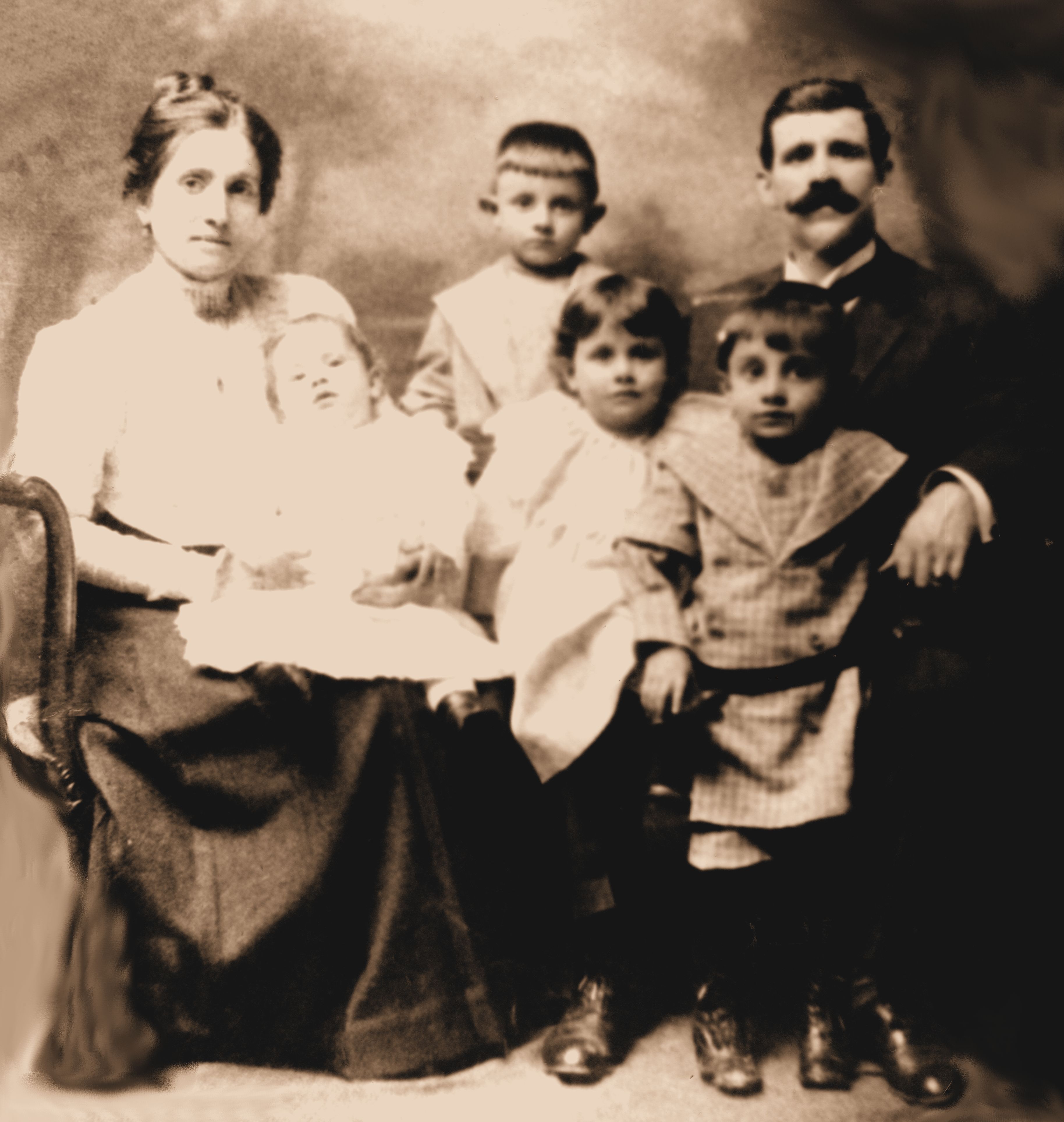 Late 1908 or early 1909: Helen, Socrates and their four oldest children: From left: Helen, George, Denis, Constantine, Xenophon, Socrates |
|||||||
 |
|||||||
|
On October 9, 1909, Socrates and Helen's fifth child, Pontelius (Ponte) was born.
The
1910 census
[46],
taken on April 28, 1910, shows the family back at the 193 Montauk Avenue
address again. Socrates, age 38, appears as head of the household with wife Helen, age 24,
and five children under the age of seven: sons Dennis, age 6; Xenophon, age
5; Constantine, age 3; George, age 2; and Pendleton
[sic](Pontelius), age 6
months. Nephews Peter Peterson, age 23; and James Peterson, age 19
were also listed as members of the household, along with Helen’s mother,
Caroline Kelessidis, age 48.
A I |
|||||||
|
Local Greeks Pay Taxes “Why do these Greeks thousands of miles beyond the reach of the sultan continue to pay tribute to him?” you ask. It is not through any desire to get rid of their money, it is not through any love for the sultan, whom they hate with an intense hatred, but because they know and fear the consequences if they fail to send their tribute to the sultan. The consequences may be feared too. If a Greek in this country fails to pay his taxes, his property, if any he has in his former home, is confiscated, sold and the money applied against the tax; of he has no property he may have relatives and if so these relatives, innocent as children of any wrongdoing, must pay the penalty. If they have property it is sold at public auction; if they have neither property on nor relatives the tax is not lost t the greedy sultan, but the amount of unpaid taxes is added to the levy and the people in the township or province are more heavily assessed to offset the loss. Thus the sultan loses not a penny of tribute. If a Greek returns to his former home for a visit, even if it is his first visit in ten or a dozen years, and has not paid his taxes while in America, the fact is not forgotten; he is seized and obliged to pay all his taxes back. So the Greek who were driven from the sultan’s domain by continued persecution, to this country, submit to the unjust tax for they know they must or suffer the dire consequences. The amount of tax paid by the New London Greeks
to their “beloved ruler” varies. On the average it is about $7.50
annually. While this is not a large amount it falls hard upon many and it
is particularly a burden when the sender realizes that it is a personal tax
and that in return he is receiving absolutely nothing; it is barefaced
robbery with the sultan hiding behind the powerful organization he has built
about him to rob his subjects. |
|||||||
|
The article names several of the Greek residents of New London - Dimon Balassi, Stavros Peterson, John Traggis, Socrates Patterson and John Patterson, brother of Socrates. The Mysterious John Patterson, Brother of Socrates The latter man mnetioned above, John Patterson, is especially interesting, because he is identified in the article as a brother of Socrates Patterson and manager of the candy store at the Schwaner Building (perhaps where Schwaner's City Market was located on 40 Main Street). The following entry was in the article: John Patterson Has Visited Turkey. "John Paterson, a. brother of Socrates, and manager of the candy store in the Schwaner building, has been in America since 1879, but although he has not lived in Turkey for some time he has visited there twice and on one of those visits had an experience which gave him an unpleasant acquaintance with the despotic rule of the sultan and his men. He had left the country and when the adair, which corresponds to the directory man in an American city, came around he was told that John Patterson was dead and so took the name off the list of taxables. Returning to the country on a visit Patterson was seized and told to pay the taxes that had accumulated in his absence. This he refused to do, and he was thrown into prison. Being an American citizen Patterson appealed to the American consul through a telegram. The consul came down immediately to Ardek and forced the authorities to turn Patterson over to him. Although he spent but 24 hours in jail it was not a pleasant experience, for even 24 hours in a Turkish prison is anything but bliss. Patterson was harassed by the officials and was advised to leave the country. He did, returning to this country. Patterson in point of number of years’ residence here leads all the local Greeks. He was for 12 years in the U.S. service as a man behind the guns. He was on the Brooklyn in the Spanish-American war and is proud of his service beneath the stars and stripes, saying "that he’s as good a citizen as any man in New London.” He has none but condemnation for Abdul Hamid, whom he laconically termed “a very bad man.” John is rather more or a pessimist than the others and even in the ascension or Mohammed Rechard Effendi he does not see much hope of better things. “The country is not good unless another power come in there,” he declared with a woeful shake or the head. “They tax you for everything.” “America,” he said, with a wide sweep of the hand, “is the freest country in the world,” and that is what all his fellow countrymen say as they rejoice at living in this freedom and prayerfully hope for better things for father, mother, brother and sister in the far off land of the Orient.” Less than a year later, an article appeared in The Day of 17 January 1910: “John Patterson, one of the first Greeks to locate here, died suddenly of a heart attack while sitting in the store of Dimon Balassi at 129 Main Street. He was a brother of Socrates Patterson, candy merchant, and had served many years in the U.S. navy.” This information was corroborated by an entry in the records of “Deaths in the Town of New London” for January 1910: |
|||||||
|
|
|||||||
|
|
|||||||
|
John Patterson, age 56 (although some records indicate he was probably 53), son of Notas and Helen Patterson (the same parents given listed for Socrates' younger sister Sotera, in her death certificate), candymaker, died at 129 Main Street on 17 January 1910 of angina pectoris (chest pain or discomfort due to coronary heart disease). He had been ill with chronic endocarditis for 2 ½ years. His doctor was W.D. Cronin (William D. Cronin, the same doctor that delivered all of Socrates and Helene Patterson’s children). He was buried at Jordan Cemetery in Waterford, Connecticut. A search of the memorials at Jordan Cemetery brought up nothing for John Patterson, but interestingly enough, there is a memorial for John Graco, who died 17 January 1910, and on his headstone is carved, “U.S.S. Brooklyn, U.S. Navy, Spanish-American War”. The date of death and military service is identical to information provided in news articles for John Patterson. It has to be the same man. |
|||||||
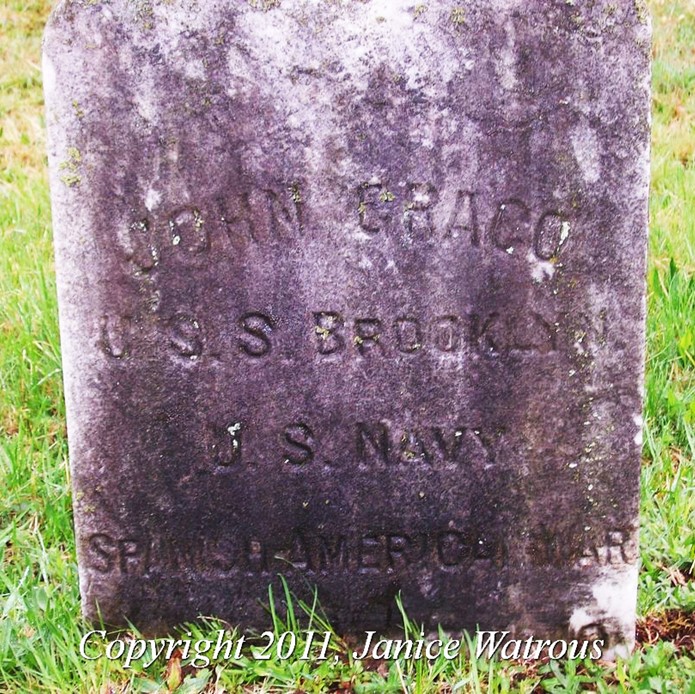 |
|||||||
|
The Headstone of John Graco (Patterson). |
|||||||
|
That John initially went by a completely different surname than Socrates is not necessarily significant. Some of the Greeks in New London adopted a variety of surnames when they arrive in the U.S. Some took the first name of their father as a surname. For example, Emmanuel Manolakis took his father’s name, Nicolaou, as his surname and later anglicized it to Nichols. Socrates Patterson’s surname was Papanagnoste (a descendant of a Greek Orthodox priest named Anagnostis), and then anglicized the name to Patterson. John was at least 13 years older than Socrates and he arrived in the U.S. about 13-14 years before Socrates, well before the decision was amde to anglicize the family name to Patterson. It’s possible that the surname “Graco” simply signified that John was Greek. Translation of Greek in Italian is “Greco”, in Spanish, “Griego”, and in French, “Grecque". A search of John Graco, born 1854-59 brought up more variations of this surname which corroborate the military history provided for John Patterson in The Day article and on his headstone. Two Naval enlistment records provide the following: 1. 7 May 1887 in New York: John Geraco, age 28, born about 1859 in Greece, fireman, 5’6”, pockmarked with scar, enisted in the Navy. |
|||||||
|
|
|||||||
|
2. 23 August 1890 in Boston, Massachusetts: John Giraco, age 31 5/12 months (so born March 1959), fireman, previously served as fireman, 5’6”, pockmarked with scar, enlisted in the Navy for a second term. |
|||||||
|
|
|||||||
|
Finally, the website https://www.spanamwar.com/Brooklynroster provides a transcription of a handwritten roster of the crew of the U.S.S. Brooklyn at the Battle of Santiago during the Spanish-American War. Included among the Naval crew is: Giraso, John, Fireman, 1st Class. This record corroborates the fact that John Patterson served on the U.S.S. Brooklyn during the Battle of Santiago in the Spanish American War, and with the two records for John Geraco and John Giraco who enlisted in the Navy as a fireman.. Early 20th century records from New London Directories provide more record of John Patterson and some of the names he appears to have gone by: • In 1901, John Giraco lived at 29 Golden Street (where Socrates had also roomed) and worked at 82 State Street. • In 1907, Girakos Patterson was a clerk at 84 State Street and lived at 193 Montauk Avenue (Socrate and Helene's address in 1920) • In 1908, John Patterson listed his occupation as confectionary, working at 153 Main Street. The same year, Girakos Patterson, clerk, was living at 193 Pearl Street. • In 1909, John Patterson, confectionary, was living at 60 Gold Street and working at 127 Bank Street. That same year, Girakos Patterson, clerk, was living at 10 Pearl Street. • In 1910, Girakos Patterson was living at 193 Montauk Avenue. To date, no records have been found of John Patterson's original arrival in the U.S. in 1879 (as noted in the 1909 article in The Day), or of his naturalization, which would probably have taken place between 1879, when he stated he arrived in the U.S., and 1887, when he first enlisted in the Navy. Because he used several variations of surnames while he was living, it's not known what name he traveled under when he arrived in the U.S. or when he applied for citizenship. |
|||||||
 |
|||||||
|
The Patterson Family Grows and Socrates' Business Flourishes |
|||||||
|
On 27 July 27 1911, Helene, claiming citizenship through the naturalization of Socrates, applied for a passport from herself, four-year-old Constantine and three-year-old George, probably to visit her family in Constantinople. [32] A ship manifest confirms the trip they took, returning aboard the Rochambeau from Le Havre on 11 November 1911.[33] Five months later, Socrates and Helene's sixth child, Demosthenes, was born on 16 April 1912. A 21 August 1912 article in The Day reported that Demosthenes was christened in a ceremony at the family home on Montauk Avenue by the Reverend Thomas Pappageorge of Newark, New Jersey. [53] Helene's cousin Constantine Kelessidis, who later was known as Gus Kelles, immigrated to the U.S. on 29 July 1912 and helped Socrates with the family business. [35] Constantine's father, Michael, a cousin of Helene's father, Georges Kelessidis, travelled from Athens in August 1913 to visit his son now staying with Helene's family [36]. A month later, Helene's father, George Kelessidis arrived to visit his daughter's family, but no doubt also to see his cousin and nephew. [37] In 1915 the family moved to a home at 45 Tilley Street [55]. The following year, Socrates purchased a store at 124 State Street adjoining the Patterson & Peterson store at 127 State Street. He moved the Crystal Candy Kitchen to 76 State Street and now listed it as a confectionary and ice cream business[56]. Running a candy store could have its hazards. On December 15, 1915, The Day [57] reported that Socrates lost a $300 diamond (more than $7,000 today) from the ring he was wearing in a batch of molasses peppermint candy he was preparing. He offered a reward for the return of the diamond, which he believed was included in the candy someone purchased. |
|||||||
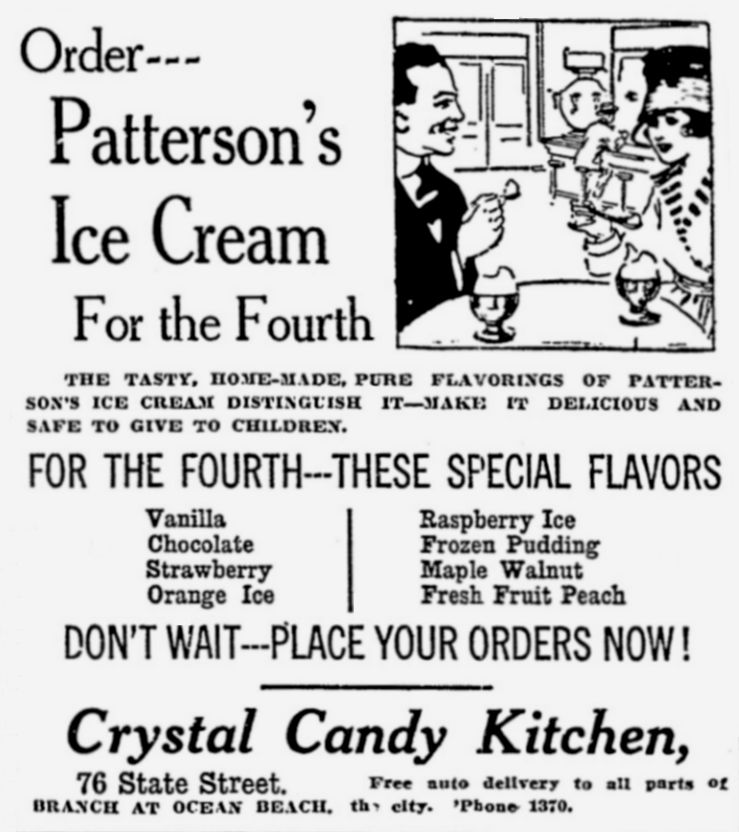 |
|||||||
 |
|||||||
| Advertisements for Patterson's Crystal Candy Kitchen from The New London Day | |||||||
|
A January 9, 1915 article in the The Day noted that throngs of people crowded into the opening of the renovated new store at 76 State Street. The interior was decorated with palms and flowers, music was provided by an orchestra, and souvenir calendars and tickets redeemable for boxes of chocolates were handed out. The new store featured a large soda fountain and spacious ice cream parlor.[58] Soon thereafter Socrates sold to his nephew, Stavros Peterson, his share of the interest in the Patterson & Peterson Candy Kitchen at 127 State Street. A March 15, 1915 article in The Day [59] clarified that Socrates had sold his interest in the joint venture with his nephew, however he had not sold The Crystal Candy Kitchen at 76 State Street and would continue to do business at this store while Stavros would continue to operate the former Patterson & Peterson's store as Peterson's Candy Kitchen. |
|||||||
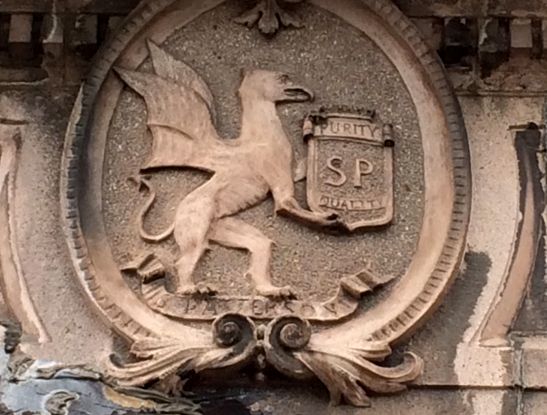 |
|||||||
|
Bas relief above the entrance of Patterson's Crystal Candy Kitchen at
76 State Street. Socrates' initials, SP, are in the shield, and "S. Patterson" is on the banner below the griffin. Photo courtesy C. Dodson, grandson of Stavros Peterson |
|||||||
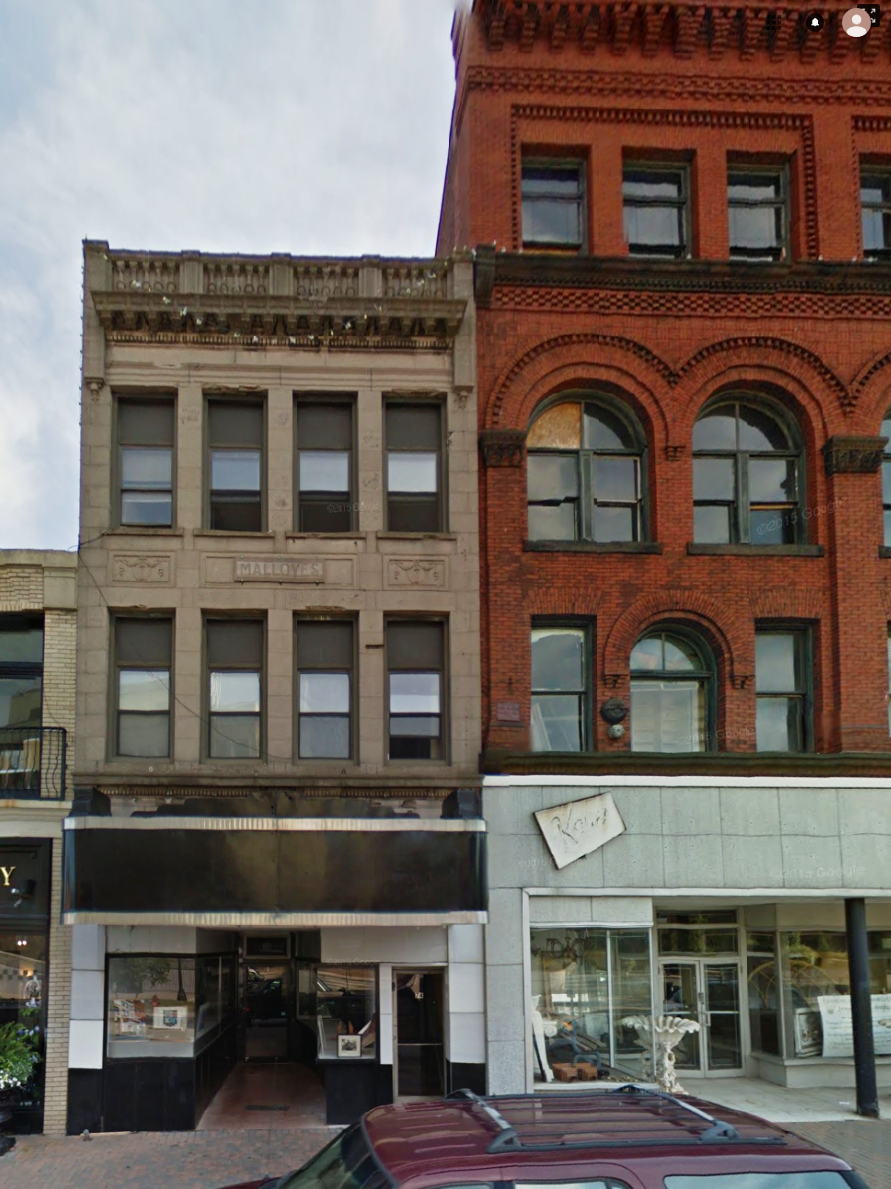 |
|||||||
|
74-76 State Street, building left, where Patterson's Crystal Candy
Kitchen was located. The bas relief, above, is hidden behind the black marquis. Patterson's first candy kitchen was located in the building on the right, the Cronin Building (80 - 88 State Street). |
|||||||
 |
|||||||
|
An 8 December 1916 article in The Day [60] reported that Socrates legally changed his name from “John Socrates Papanagnosti” to “Socrates Patterson”, with equivalent name changes for his family. At this point, Socrates' life in America was a success by all accounts. He had fulfilled the American dream. He built up a prosperous business from practically nothing, having arrived in this country at barely 21 years of age and with two bags of possessions to his name; he was a father of a thriving brood of children. He was a respected resident of New London and a pillar of New London's Greek community.
M |
|||||||
| This is possibly the last communication young Constantine had with his father. | |||||||
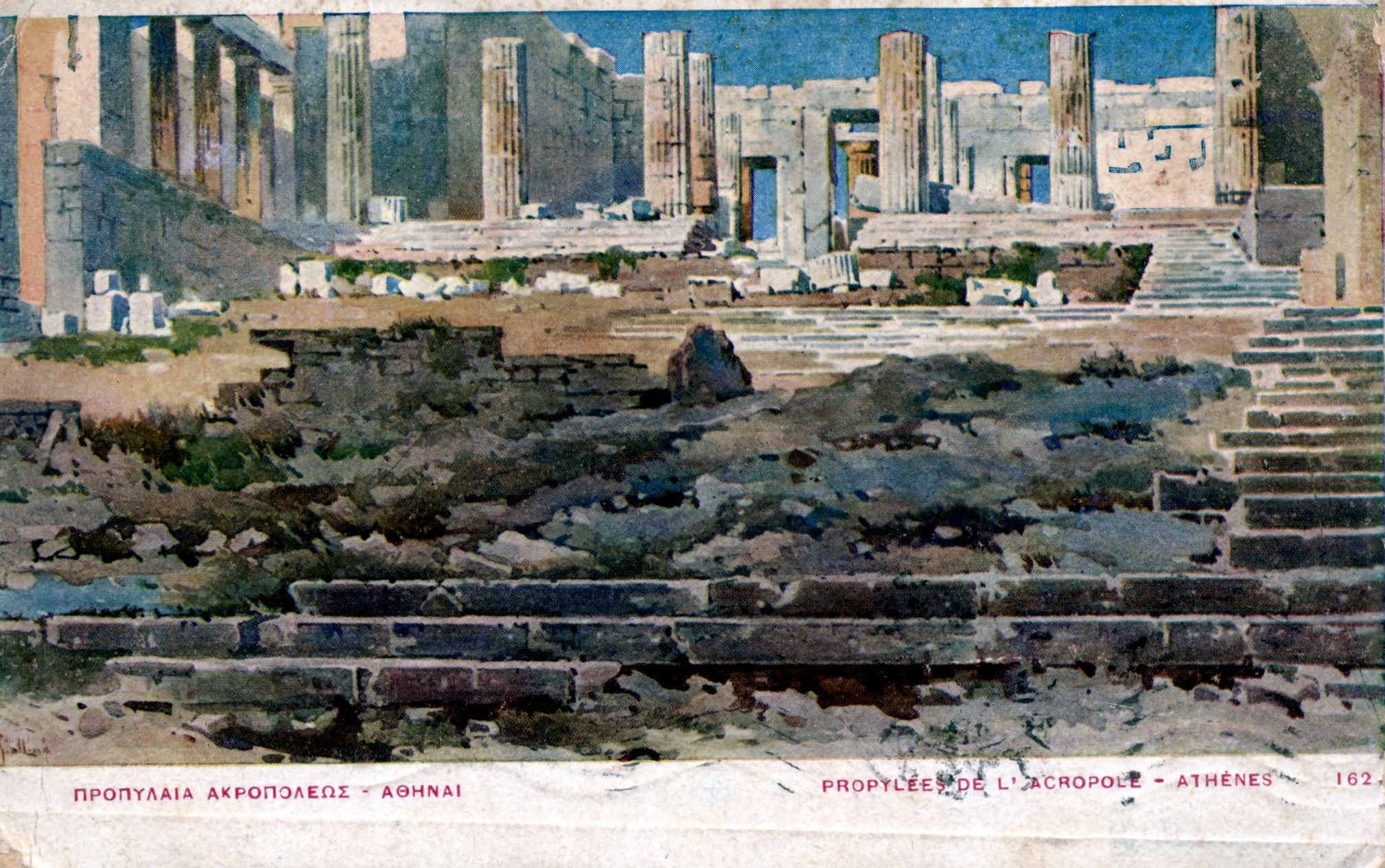 |
|||||||
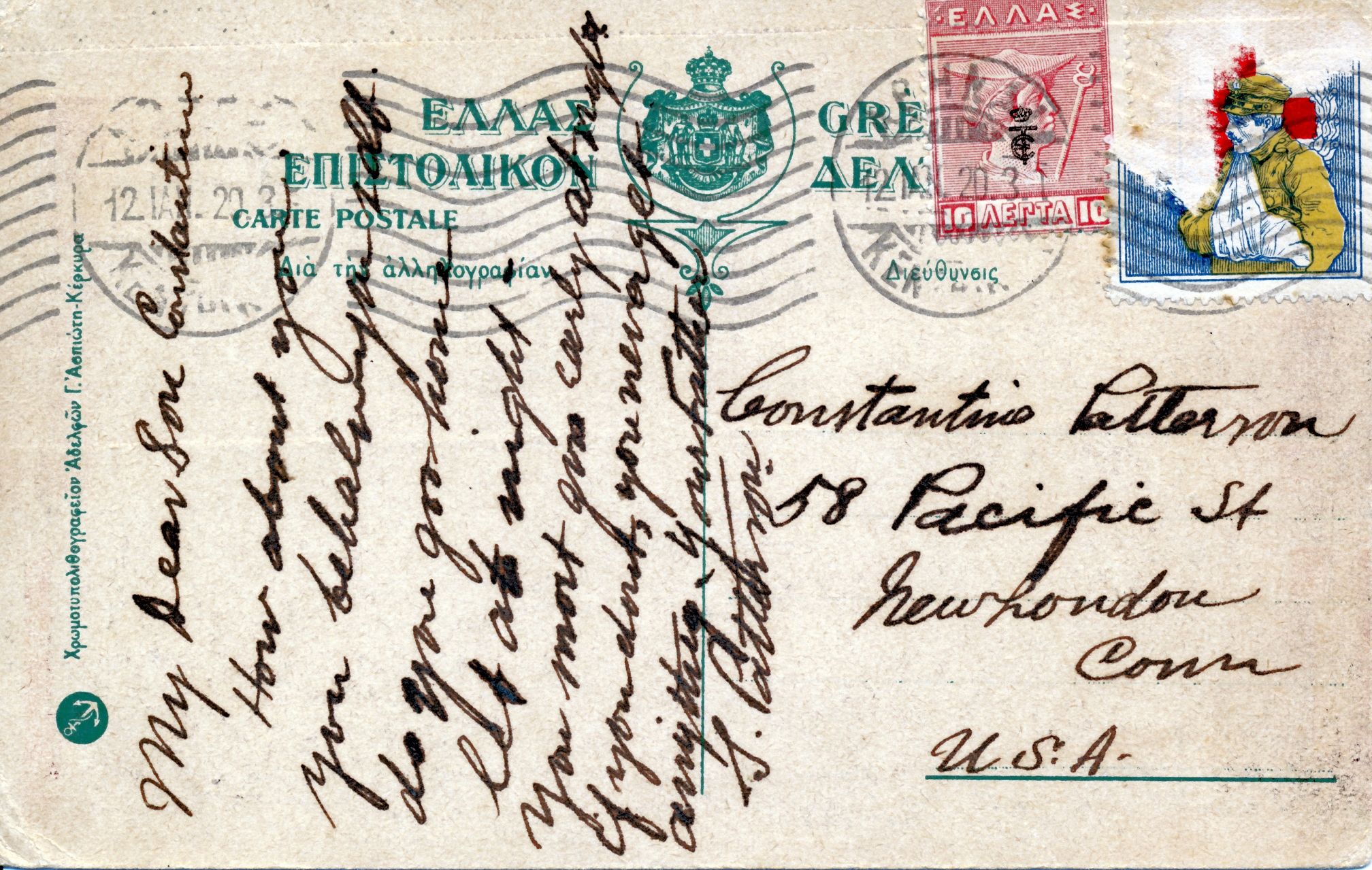 |
|||||||
|
A month later, Socrates wrote the following letter to his 11-year-old son George: Konstantinople February 11/24/20 My Dear Son George |
|||||||
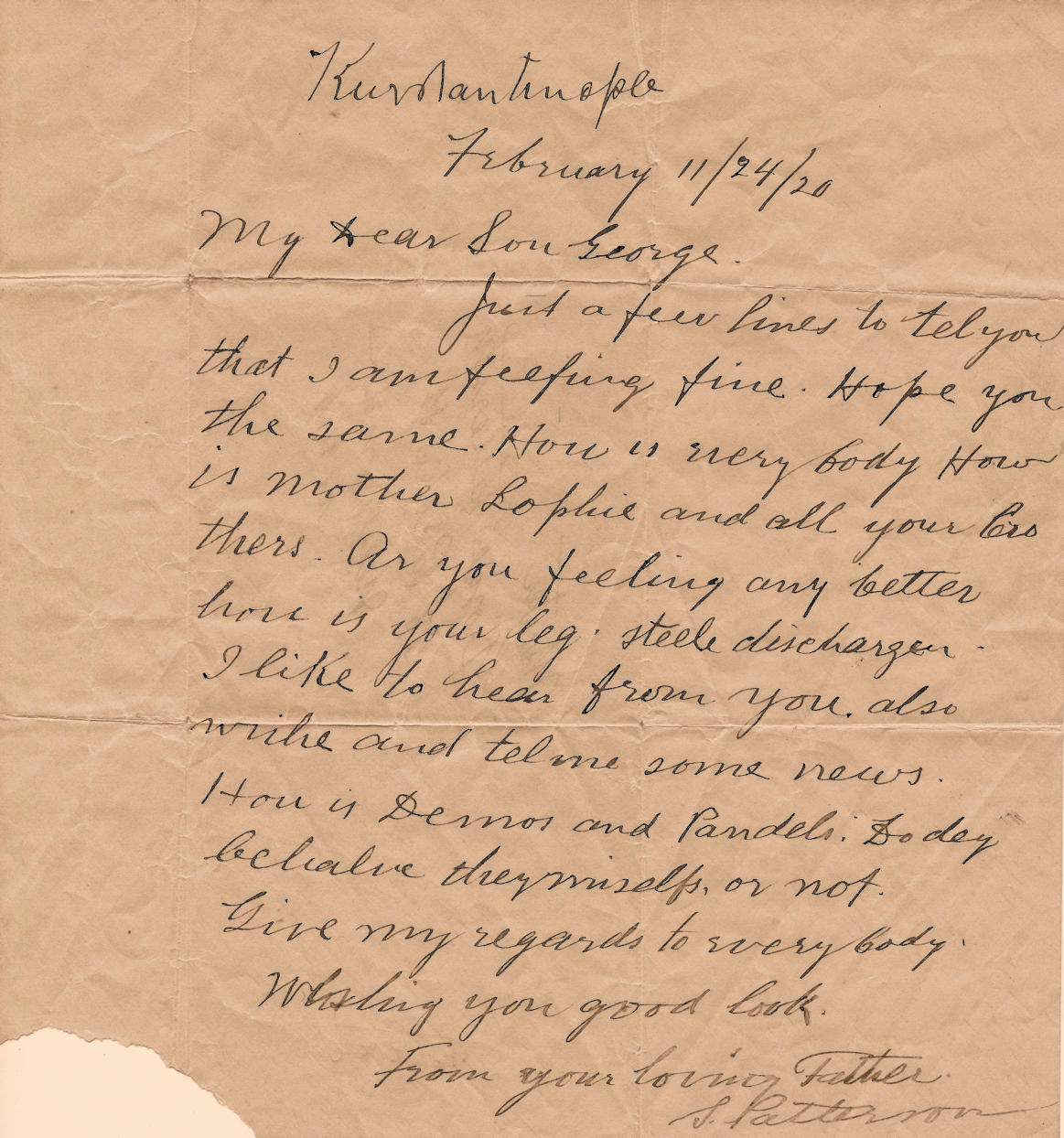 |
|||||||
|
Although the living family knows little else of Socrates' activities abroad in 1920, it is clear that his health progressively deteriorated. On 19 March 1920, the American Consulate issued a Report of the Death of an American Citizen [68], stating that Socrates Patterson, a naturalized citizen, had died 16 March 1920 at the Hospital Franchet d’Esperey in Constantinople of kidney disease. He had been accompanied on the trip by his nephew, S.F. Peterson (Stavros Peterson). Socrates was buried at the Şişli (Chichli ) Greek Orthodox Cemetery in Constantinople, and his effects were given to his father-in-law, George Kelezides [sic] of Passage Crespin, Pera, Constantinople. The report listed Socrates’ residence as Pacific Street, New London, Connecticut. He was 47 years old. Socrates was survived by Helene, now 34, and seven children between the ages of 16 and one. It is interesting that a note at the bottom of the page states, “Certificate of death issued by the Oecumenical Patriarchate March 3rd, 1920", so perhaps this was the actual date of his death, and the date of burial was March 16. Articles in The Day and the Norwich Bulletin reported on Socrates' death locally.[69; 70] A 24 May 1920 article in the Norwich Bulletin announced that Socrates' will was filed in probate court. His estate was valued at $100,638.48 (worth about $1,376,568.35 today), bequeathed entirely to his wife Helene.[71]
|
|||||||
|
|
|||||||
|
|||||||
 |
|||||||
|
|||||||
|
The leaf graphic on this page is from the stencil, Olive Branch, by the Dressler Stencil Company. |
|||||||
|
The background paper for this page is from |
|||||||
| Last updated: Wednesday, May 11, 2022 06:06:21 PM | |||||||



